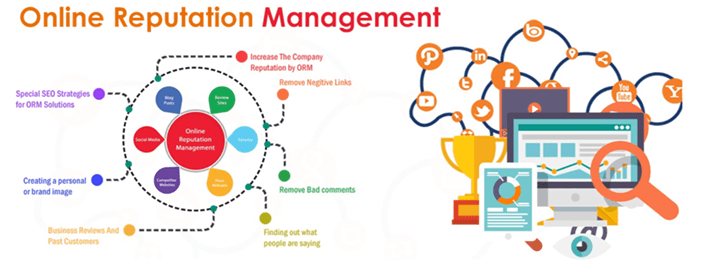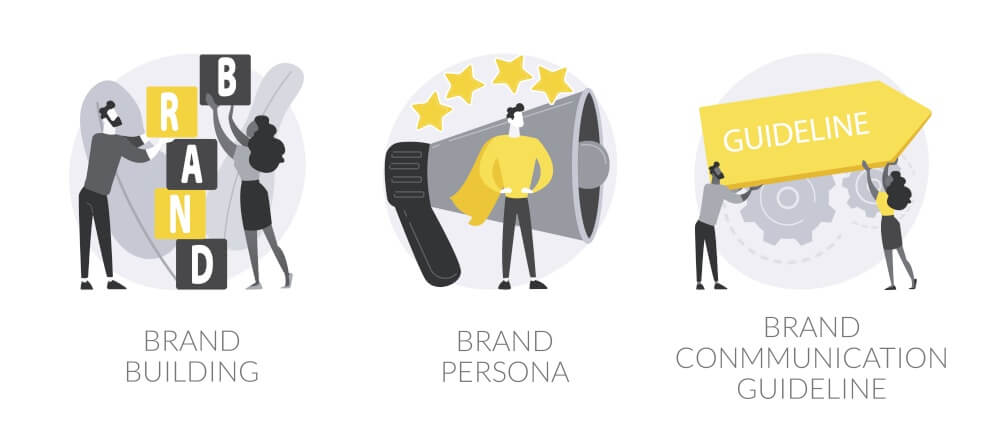What Is Online Reputation Management?

Written by: Adam
May 3rd, 2021
Table of Contents
Getting Familiar With Reputation Management
What Is a Reputation Management Strategy?
What Are The Four Elements Of Reputation Management?
1. Core Values
Mission
Vision
Company Values
A Company’s Core Values Build The Brand Persona
So Then, What Is Brand Persona?
Brand Voice
Brand Tone
2. Customer Perception And Customer Trust
The Importance Of Customer Perception For Reputation Management
Managing Brand Reputation Online
3. Individual Behavior And Responsibility
Managing Customer Reviews For Reputation Management
Supporting Customer Reviews
The Importance Of Customer Perception For Reputation Management
Engaging With Positive Reviews
Dealing With Negative Reviews
4. Accountability In Business
In 2021, businesses need to grow and nurture their online reputation management to drive success.
The modern customer expects stellar performance from a company. They also expect brands to abide by a set of core values, meaning the products and services a company sells are not just transactions. They embody the company’s voice with which its customers resonate.
When done right and with purpose, this can be immensely beneficial. It helps create a customer base that believes in your brand builds loyalty. And loyalty goes a long, long way!
However, maintaining this relationship with your customers requires a solid online reputation management strategy.
A company’s online reputation is its business card. It’s the first and the last impression that customers get. It’s also sort of a living entity, changing and growing along with the company’s development, its products, and customer reviews.
Maintaining a positive, long-lasting reputation requires steady management. It’s an ongoing process that ensures both customers get a positive impression of the company.
This is not only based on the products and services you sell, but also on your online presence.
Read on to learn what reputation management is, how to build a strategy for business success, and which elements you should focus on most.
Getting Familiar With Reputation Management
A common misconception is that brand reputation relies solely on the quality of products or services you provide.
Because of this, many business owners believe the path to success relies on product perfection.
Another misconception is that product and/or service quality speaks for itself.
For sure, your products are an essential element. Still, there’s a lot more to consider when it comes to reputation management. Your success relies not only on product quality, but also on perception and your ability to respond to customer needs.
For this, online brand marketing and customer service are just as important as developing the product itself.
What’s more: these elements must create a unified front that tells your brand’s story using its own voice and tone.
What Is a Reputation Management Strategy?
The sum of the actions you take to manage brand perception is ultimately your reputation management strategy. This strategy must account for all the potential factors that influence public opinion.
The aim is to protect your company’s positive image, spark engagement with customers, and earn brand trust.

What Are The Four Elements Of Reputation Management?
What Are The Four Elements Of Reputation Management?
1. Core Values
When building a brand, it’s essential to define the values that shape your brand persona. These tell customers who you are and, as a result, spark engagement across the web.
Mission
Your mission tells people about the specific needs your company aims to meet. It also speaks to the problems that your products and services solve.
Vision
What is brand vision? Your vision tells people how your company aims to deliver on its promises. It also includes your company’s plans to stay on top of customer needs, even those that may pop up in the future.
Company Values
Company values show what your company stands for, what drives you forward, and how you build solutions for your audience.
So Then, What Is Brand Persona?
Brand persona is your company’s virtual presence. And, as you can guess, how this persona represents your brand impacts your reputation management big time.
This fictional persona embodies your company’s core values and brings your mission and vision to life. According to their identity, brands embody an archetype and have a personality.
Depending on the approach, your brand can be the humble hero, who always comes to the customer’s rescue and strives to be their trusted sidekick. Or the jester, who is playful and cheery and brings joy and entertainment.
You can also be the superhero, always saving the day and inspiring customers to look up to him. These are just a few examples, but you get the gist!
Brand Voice
Customer interaction involves communication. And even though this happens on a variety of different channels, it must always represent the brand persona. Customer communication must always be carried out in the brand’s voice.
A brand that embodies the personality of the humble hero sounds differently from one that is the jester, the superhero, the caregiver, the lover, or any of the others.
When building a reputation management strategy, all communication must be carried out in your brand voice, as this will contribute to your reputation.
Once you nail this, your customers will associate your brand with its personality. It’s important that your messaging be aligned with this to build cohesiveness.
Brand Tone
Also corresponding to a brand’s personality is the tone used in all communications.
If your brand were a person, how would it speak? Your tone must be clearly defined and used throughout all communications. From product descriptions to ads, blog posts, and emails, and all the way to customer service.
If the foundation of your company’s mission is to meet customer needs, you must determine the ideal tone your potential and existing buyers would engage with.
How would they want you to talk to them?
Determine and use this to guide the tone throughout all your messaging to build a successful reputation management strategy. This includes proofreading every document and communication piece, training employees to use the brand’s tone and voice, and adhering to company values in their work.
2. Customer Perception And Customer Trust
The customer’s perception of your brand begins at the very first interaction. This interaction is usually initiated by the brand through an ad, a social media post, blog, or another type of marketing product.
From this first interaction on, the customer has an opinion about your brand. Then, as the customer interacts further with your services, they build an informed opinion of your brand.
The next steps typically include interactions with your company’s website, customer service desk, and other brand touchpoints, such as invoices or contracts.
Based on their perception, customers will choose both if they want to become loyal consumers and if —and how— they’ll tell other people about your brand.
The Importance Of Customer Perception For Reputation Management
According to customer service statistics, positive customer experiences inspire the customer to return and to recommend your brand to others.
Negative experiences, however, usually encourage the customer to switch to a competitor’s brand and tell others they were unhappy about the experience.
- 77% of customers will recommend your brand to a friend after a single positive experience.
- It takes as many as 12 positive customer experiences to compensate for a single negative experience.
- Typically, satisfied customers share their positive experiences with 9 people. Dissatisfied customers share their negative experiences with 16 people.
- Following a bad experience with customer service, 40% of customers will recommend their friends not to do business with your brand.
- 8 in 10 customers would consider changing companies after a negative experience with customer service.
- After a dissatisfactory customer service experience, 39% of customers will avoid your brand for as long as 2 years
Maintaining a positive customer perception is only possible through a solid reputation management strategy.
Customer trust is earned through positive experiences and good reviews. However, it can be quickly lost to negative experiences when reviews aren’t managed correctly.
Managing Brand Reputation Online
In 2021, creating and maintaining a consistent online presence is extremely important. This is because it builds up from the first interaction with your potential customers.
Search engine optimization (SEO) lies at the core of your online presence. This is what connects your website with the organic pathways your potential customers use to find you.
In short, SEO enables you to appear in the first search results for the phrases people use to find what you offer.
A strong SEO strategy helps make your site more visible. Simply put, it targets the main set of keywords associated with your brand. You’ll also be able to target some less obvious keywords connected to related user searches.
And, a good SEO strategy helps ensure your content adds value and responds to what customers are looking for on the web.
SEO drives organic traffic to your platform by making your content the best resource for what users need.
As part of your site’s optimization campaign, SEO will also power reputation management by emphasizing branded search.
When people type in the name of your company in Google, is your website the first result?
While you might expect this to be the obvious outcome, it’s not always the case!
You have to make sure your branded content is properly optimized to get the best results.
And, setting up your company’s Google My Business account should never be overlooked. This way, you can control what users see in the snippet about your company when they type your company’s name.

3. Individual Behavior And Responsibility
Your company’s reputation is built on general customer interaction, such as with ads or social media posts.
And even though these are designed for all or specific segments of your customer base, individual experiences with brand representatives can “make or break” your reputation.
Therefore, employee behavior must be in line with the company’s core values, brand persona, and brand voice.
As an example, if the brand is the caregiver, then all customer-facing employees must strive to reinforce the caregiver image. The language and the tone they use must make the customer feel safe and protected.
A grumpy attitude, an overly familiar tone, or a tendency to make jokes will make the interaction inadequate for customers. Why? Because customer expectations were built on the established caregiver personality.
Another example of individual behavior is the customer’s actions towards the brand. Following an interaction with a company, customers write reviews, give ratings, and tell other people about the company’s products or services.
So nowadays, customer reviews are an essential driver of brand reputation.
According to research, nearly 90% of customers are influenced by positive customer feedback when making a purchase.
Managing Customer Reviews For Reputation Management
Customer reviews have the power to persuade or dissuade prospects from making a purchase with a company.
Keeping track of reviews and using them to generate a positive experience should be an essential point of your ORM strategy (Online Reputation Management).
Customers express their opinions through reviews, be it positive or negative. It’s up to your company to interact with these in the best possible way.
Supporting Customer Reviews
What;s worse than having negative reviews? Having no reviews at all.
Your reputation management plan must include actions that encourage customers to review your brand. First and foremost, your platform must technically support customer reviews.
You should also make sure you are present on review sites like Trustpilot or Yelp.
The next step is mapping out the customer journey. This helps point out the ideal moments when people are likely to provide reviews. Based on this, you can build touchpoints that encourage more reviews.
For example, an ideal time to ask for a review is after a customer receives their order, or has seen or engaged with your product.
You can contact customers via email or SMS. To encourage customers to review your products, give them an incentive! You can offer something in return, like a small discount or a small token of your appreciation.
Engaging With Positive Reviews
Turn customer reviews into conversations by engaging with those who left a positive review.
Thank them and tell them that their opinion is important to you. This is one of the simplest and most effective reputation management tools you can use.
It helps make customers feel appreciated, and provides an authentic experience with your brand.
A quick response to a positive review can turn a positive experience into a stellar one.
Dealing With Negative Reviews
Negative customer reviews are often perceived as something to be avoided at all costs. But that’s not always the case.
Negative reviews can often be turned into positive experiences when managed correctly.
When a customer gives a negative review, you get to respond to it just as you would to a positive one. In fact, how you respond to negative reviews should be a pillar of your reputation management plan.
When a customer writes a bad review, it means that they have a problem with your products or services. What happens next is up to you.
You can either argue with the customer and dismiss their problem, or you can use it as an opportunity to help.
A candid response, a sincere apology, and an offer to assist them may have a huge potential that turns this negative experience around. This is important not only for that customer, but also for all the other potential customers who will read that review.
4. Accountability In Business
Your company’s reputation is built on the reliability of your products and/or services. Before any other reputation management step can be taken, you must first abide by the legal requirements of your industry.
You must also adhere to standards, respect laws, and support a positive work environment for their employees.
This must be backed up by solid legal documents that can hold your brand accountable should you fail to respect the promises made to customers and employees.

To sum up, reputation management is the full array of actions that companies use to shape brand perception.
This includes everything from establishing and maintaining your core values and brand persona to applying a solid SEO strategy, taking control of customer reviews and maximizing your online potential.
At Net Reputation, our online reputation team helps you build and maintain your reputation. We also offer internet privacy solutions that ensure your online journey is safe, positive and productive.
To find out more about our online reputation management services, just get in touch with us!
In the meantime, take a look at:
Complete Public Relations Strategy Guide
What Is Reverse SEO?
Why Is Your Online Reputation Important?

